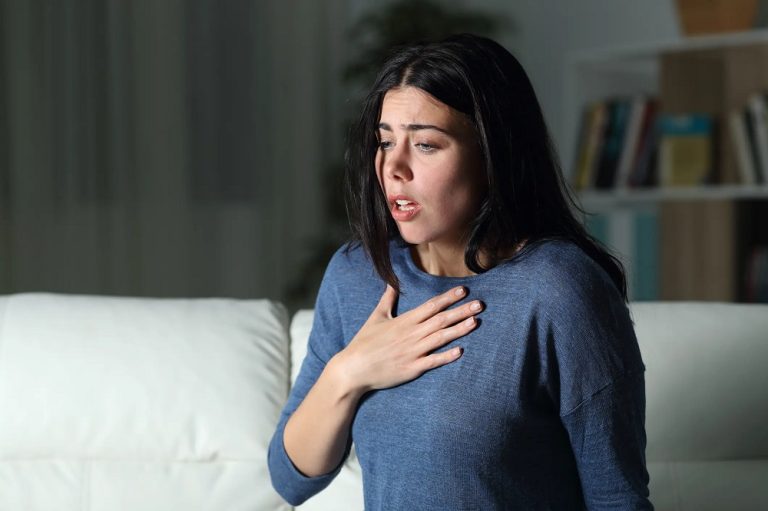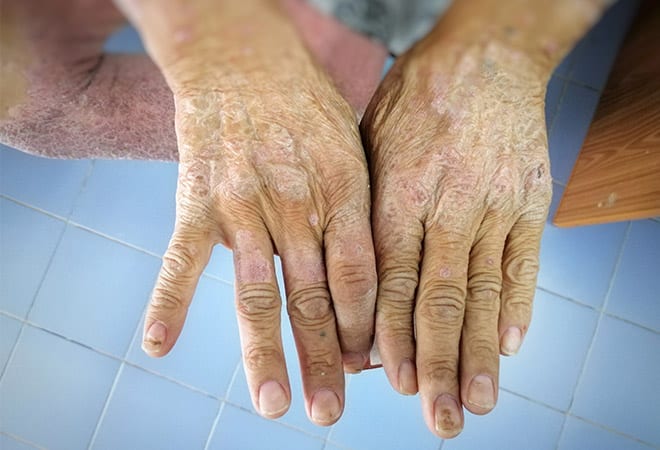
Psoriasis: Causes, Symptoms, Diagnosis, and Treatment
Psoriasis is a chronic autoimmune condition that affects the skin, causing red, scaly patches that can be itchy, painful, and sometimes debilitating. Over 8 million people in the United States and approximately 125 million worldwide live with psoriasis, according to the National Psoriasis Foundation. Psoriasis can also lead to joint pain, emotional distress, and other health complications. Understanding its causes, symptoms, diagnosis, and treatment options is essential for managing this lifelong condition.
What Is Psoriasis?
Psoriasis is a non-contagious, autoimmune disorder that accelerates the growth cycle of skin cells. Normally, skin cells grow and shed over a month, but in psoriasis, this process occurs in days, leading to a buildup of thick, scaly patches called plaques. Psoriasis can affect any part of the body, including the scalp, elbows, knees, and lower back, and may also involve nails and joints in some cases.
The condition varies in severity, from mild localized patches to severe cases covering large areas of the body.
Causes of Psoriasis
The exact cause of psoriasis remains unclear, but it results from a combination of genetic, immune, and environmental factors. Here are the primary contributors:
1. Immune System Dysfunction
Psoriasis is an autoimmune disorder where the immune system mistakenly attacks healthy skin cells. T-cells, a type of white blood cell, become overactive, triggering inflammation and rapid skin cell turnover. According to the National Institute of Arthritis and Musculoskeletal and Skin Diseases (NIAMS), “In psoriasis, the immune system is mistakenly activated, which leads to overproduction of skin cells”.
Understanding Jaundice: Causes, Symptoms, Prevention, and Treatment
2. Genetics
A family history of psoriasis increases the likelihood of developing the condition. About one-third of people with psoriasis have a close relative with the disease. Specific genetic markers, such as HLA-Cw6, are strongly associated with psoriasis.
3. Environmental Triggers
Certain factors can trigger or worsen psoriasis flare-ups, including:
- Stress: Emotional stress is a well-known trigger for psoriasis flares.
- Infections: Streptococcal throat infections, particularly in children, can trigger guttate psoriasis.
- Skin Injuries: Cuts, burns, or sunburns (known as the Koebner phenomenon) can cause psoriasis to appear at the injury site.
- Medications: Drugs like lithium, beta-blockers, and antimalarials may exacerbate symptoms.
- Weather: Cold, dry weather can worsen psoriasis, while sunlight may improve it for some.
Triggers are not the same for everyone. They may also change over time as you age.
Symptoms of Psoriasis
Psoriasis symptoms vary depending on the type and severity of the condition. Common symptoms include:
- Red patches with silvery-white scales: These plaques are often itchy or sore.
- Dry, cracked skin: May bleed in severe cases.
- Thickened or pitted nails: Nails may become discolored or separate from the nail bed.
- Joint pain or stiffness: Seen in psoriatic arthritis, which affects up to 30% of people with psoriasis.
- Itching or burning sensations: Particularly during flare-ups.
Understanding Q Fever: The Forgotten Zoonotic Infection
Types of Psoriasis
There are several forms of psoriasis, each with distinct characteristics:
- Plaque Psoriasis: The most common type, characterized by raised, red patches covered with silvery scales.
- Guttate Psoriasis: Small, dot-like lesions, often triggered by infections like strep throat.
- Inverse Psoriasis: Smooth, red patches in skin folds, such as under the arms or groin.
- Pustular Psoriasis: White, pus-filled blisters surrounded by red skin, often localized to hands or feet.
- Erythrodermic Psoriasis: A rare, severe form causing widespread redness and shedding of skin.
- Scalp Psoriasis: Affects the scalp, causing scaling and hair loss in severe cases.
- Psoriatic Arthritis: Combines skin symptoms with joint inflammation, stiffness, and pain.
Each type of psoriasis has very distinct symptoms and characteristics, and some are more common than others.
Diagnosis of Psoriasis
Diagnosing psoriasis typically involves a combination of physical examination and medical history review. Dermatologists are trained to identify psoriasis based on its characteristic appearance. Key diagnostic steps include:
- Physical Exam: A doctor examines the skin, scalp, and nails for signs of psoriasis.
- Medical History: Questions about family history, triggers, and symptoms help confirm the diagnosis.
- Skin Biopsy: In rare cases, a small skin sample is taken and examined under a microscope to rule out other conditions like eczema or fungal infections.
According to the American Academy of Dermatology, “A dermatologist can often diagnose psoriasis by looking at your skin, scalp, and nails.”. If psoriatic arthritis is suspected, blood tests or imaging (X-rays, MRI) may be used to assess joint involvement.
Obesity: Causes, Risks, and Weight Management
Treatment Options for Psoriasis
While there is no cure for psoriasis, treatments can effectively manage symptoms and improve quality of life. Treatment plans are tailored to the type, severity, and location of psoriasis, as well as the patient’s overall health. Treatments fall into three main categories: topical, systemic, and phototherapy.
1. Topical Treatments
Topical treatments are applied directly to the skin and are often the first line of defense for mild to moderate psoriasis.
- Corticosteroids: Reduce inflammation and slow skin cell turnover. Available in creams, ointments, or gels (e.g., hydrocortisone, clobetasol).
- Vitamin D Analogues: Slow skin cell growth (e.g., calcipotriene, calcitriol).
- Retinoids: Normalize skin cell growth (e.g., tazarotene).
- Calcineurin Inhibitors: Reduce inflammation and plaque buildup (e.g., tacrolimus, pimecrolimus), often used for sensitive areas.
- Coal Tar: Reduces scaling and itching, available in shampoos, creams, or bath solutions.
- Moisturizers: Hydrate dry skin and reduce itching.
Topical corticosteroids are the mainstay of psoriasis treatment for mild cases.
2. Phototherapy (Light Therapy)
Phototherapy involves exposing the skin to controlled amounts of ultraviolet (UV) light under medical supervision.
- UVB Phototherapy: Controlled UVB light slows skin cell growth and reduces inflammation.
- Psoralen plus UVA (PUVA): Combines a light-sensitizing medication (psoralen) with UVA light for severe cases.
- Excimer Laser: Targets specific areas with concentrated UVB light.
Phototherapy can be highly effective for treating moderate to severe psoriasis.
3. Systemic Treatments
Systemic treatments are prescribed for moderate to severe psoriasis or when topical treatments are ineffective. These include oral or injectable medications that affect the whole body.
- Oral Medications:
- Methotrexate: Slows skin cell production and reduces inflammation.
- Cyclosporine: Suppresses the immune system but requires careful monitoring due to side effects.
- Acitretin: A retinoid that normalizes skin cell growth.
- Biologics: Injectable drugs that target specific parts of the immune system, such as tumor necrosis factor (TNF), interleukin-17 (IL-17), or IL-23. Examples include adalimumab, etanercept, secukinumab, and ustekinumab.
- Small Molecule Treatments: Apremilast (Otezla) reduces inflammation by targeting specific enzymes.
Kidney Stones: Treatment, Prevention, Foods to Avoid, and What to Expect
4. Complementary and Alternative Therapies
Some patients explore complementary therapies to manage symptoms, though these should be used alongside medical treatments:
- Aloe Vera: May reduce redness and scaling.
- Fish Oil: Omega-3 fatty acids may reduce inflammation.
- Stress Management: Techniques like yoga, meditation, or therapy can help manage stress-related flares.
Lifestyle and Home Remedies
Lifestyle changes can complement medical treatments and reduce flare-ups:
- Moisturize Regularly: Use fragrance-free, hypoallergenic moisturizers to keep skin hydrated.
- Avoid Triggers: Identify and avoid personal triggers, such as stress, alcohol, or certain foods.
- Maintain a Healthy Diet: A balanced diet rich in anti-inflammatory foods (e.g., fruits, vegetables, fatty fish) may help. Some evidence suggests gluten-free diets benefit those with gluten sensitivity (National Psoriasis Foundation, Diet and Psoriasis).
- Limit Alcohol and Smoking: Both can worsen psoriasis and interfere with treatment efficacy.
- Bathe Properly: Use lukewarm water and mild soaps, and avoid scrubbing affected areas.
Complications of Psoriasis
Psoriasis is more than a skin condition; it’s associated with several comorbidities:
- Psoriatic Arthritis: Causes joint pain, swelling, and stiffness.
- Cardiovascular Disease: Psoriasis increases the risk of heart disease and stroke due to chronic inflammation.
- Mental Health Issues: Depression and anxiety are common due to the emotional toll of visible symptoms.
- Other Conditions: Type 2 diabetes, obesity, and inflammatory bowel disease are more prevalent in people with psoriasis.
People with psoriasis have a higher risk of developing other serious health conditions, according to American Academy of Dermatology (AAD).
Diagnosis and Management: What to Expect
Diagnosis Process
A dermatologist typically diagnoses psoriasis based on a visual exam and medical history. In some cases, a biopsy confirms the diagnosis by ruling out similar conditions like eczema or lupus. If joint symptoms are present, a rheumatologist may assess for psoriatic arthritis.
Managing Flare-Ups
Managing psoriasis involves a combination of medical treatment, lifestyle adjustments, and trigger avoidance. Regular follow-ups with a healthcare provider are crucial to adjust treatments as needed. Patients should track symptoms and triggers to identify patterns.
Pneumonia: Symptoms, Treatment, and Recovery Timeline
Emotional and Social Impact
Psoriasis can affect self-esteem and social interactions due to visible symptoms. Support groups, counseling, or connecting with organizations like the National Psoriasis Foundation can provide emotional support and resources.
Prevention and Long-Term Outlook
While psoriasis cannot be prevented, managing triggers and adhering to treatment can reduce flare-ups and improve quality of life. Early intervention and consistent care are key to preventing complications like psoriatic arthritis or cardiovascular issues.
The long-term outlook for psoriasis varies. Some people experience occasional mild flares, while others face chronic severe symptoms. Advances in treatments, particularly biologics, have significantly improved outcomes for many patients.
Conclusion
Psoriasis is a complex, chronic condition that requires a multifaceted approach to manage effectively. By understanding its causes, recognizing symptoms, seeking proper diagnosis, and exploring treatment options, individuals can take control of their condition. From topical therapies to biologics and lifestyle changes, there are many ways to reduce symptoms and prevent complications. Always consult a healthcare professional for a personalized treatment plan tailored to your needs.
With the right strategies, you can manage psoriasis and live a fulfilling life.







